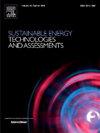芦竹制备生物喷气燃料的LCA和TEA分析
IF 7
2区 工程技术
Q1 ENERGY & FUELS
Sustainable Energy Technologies and Assessments
Pub Date : 2025-02-11
DOI:10.1016/j.seta.2025.104233
引用次数: 0
摘要
本研究分别对芦竹醇生产生物燃料的气化、热解、发酵、解聚四种工艺进行了技术分析、LCA、TEA和综合决策评价。以阿伦多纳克斯为原料生产的可持续航空燃料具有良好的减排效果。考虑土壤固碳(SCS)后,各工艺减排效果均显著提高。气化变成了负碳,减少了102.63%的排放量。若将热解副产物生物炭作为固碳产物,减排效果可达198.02%。从阿伦多纳克斯提取的生物燃料通常比传统航空燃料需要更多的水。然而,热解过程的水足迹(WF)明显较小。在经济效益方面,以年产3万吨航油及其他产品为目标,结果表明,热解工艺经济性较好,净现值(NPV)最大,为284149万元,内部收益率(IRR)为36.22%,其次为解聚工艺。随后,采用基于向量的算法结合不确定条件下的多准则决策方法,发现热解具有最佳的可持续性性能,主要是由于WF最低,技术成熟度和政策支持较高,而解聚具有更平衡的属性性能和最佳的相对可持续性性能,表明中国应首先重点发展热解和解聚技术。本文章由计算机程序翻译,如有差异,请以英文原文为准。

LCA and TEA analyses of bio-jet fuel prepared from Arundo donax
Here, four processes, gasification, pyrolysis, fermentation, and depolymerization, for producing biofuel from Arundo donax were successively subjected to technical analysis, LCA, TEA, and comprehensive decision-making evaluation. Sustainable aviation fuels produced from Arundo donax have good emission reduction effects. After considering soil carbon sequestration (SCS), all the process emission reduction effects are significantly improved. Gasification became carbon-negative, reducing emissions by 102.63%. If the by-product of pyrolysis, biochar, is used as a carbon sequestration product, the emission reduction effect can reach 198.02%. Biofuels made from Arundo donax generally require more water than traditional aviation fuels. However, the pyrolysis process has a significantly smaller water footprint (WF). In terms of economic benefits, targeting an annual production of 30,000 tons of jet fuel and other products, the results show that pyrolysis has better economics with the largest net present value (NPV) of 2841.49 million yuan, and the internal rate of return (IRR) is 36.22%, followed by depolymerization. Subsequently, using a vector-based algorithm coupled with multicriteria decision-making approaches under uncertainty conditions, it was found that pyrolysis has the best sustainability performance, mainly due to the lowest WF and higher technology maturity and policy support, while depolymerization has more balanced attribute performance and the best relative sustainability performance, indicating that China should focus first on developing pyrolysis and depolymerization technologies.
求助全文
通过发布文献求助,成功后即可免费获取论文全文。
去求助
来源期刊

Sustainable Energy Technologies and Assessments
Energy-Renewable Energy, Sustainability and the Environment
CiteScore
12.70
自引率
12.50%
发文量
1091
期刊介绍:
Encouraging a transition to a sustainable energy future is imperative for our world. Technologies that enable this shift in various sectors like transportation, heating, and power systems are of utmost importance. Sustainable Energy Technologies and Assessments welcomes papers focusing on a range of aspects and levels of technological advancements in energy generation and utilization. The aim is to reduce the negative environmental impact associated with energy production and consumption, spanning from laboratory experiments to real-world applications in the commercial sector.
 求助内容:
求助内容: 应助结果提醒方式:
应助结果提醒方式:


